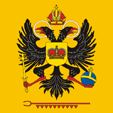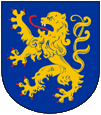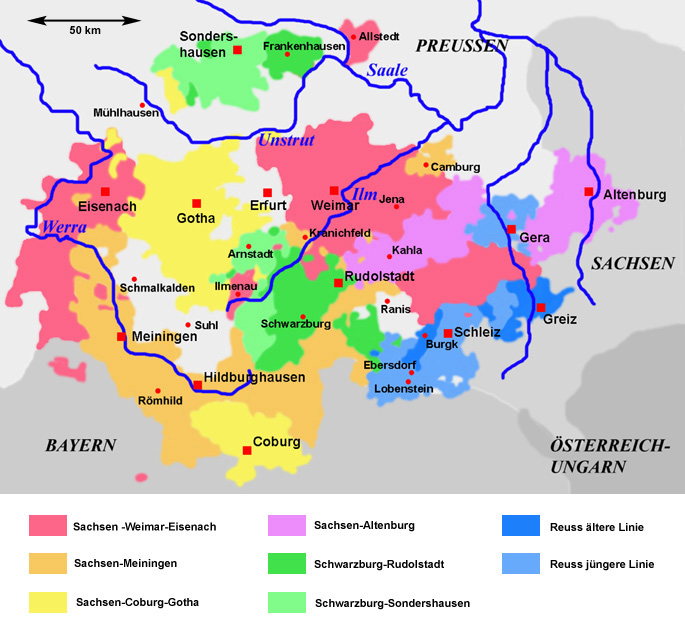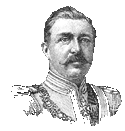mobile View, to the German Version tap the flag


- Principality of Schwarzburg–Rudolstadt (to 1918)
- to 1920 country of the German Empire
- 1920 merged into Thuringia
• Flags
• Meaning/Origin of the Flag
• Coat of Arms
• Meaning/Origin of the Coat of Arms
• Cockade
• Map
• Numbers and Facts
• History
• Origin of the Country's Name

ca.1820–1920,
Flag of the country,
ratio = 3:5,
Source, by: Jens Hild




to 1918,
Flag of the Prince,
Source, by: Flags of the World,
Deutsche Wappen Rolle






The colors of the Lords of Schwarzburg should really be gold and blue, derived from the house crest. It shows a golden lion on a blue background. The line of the counts of Schwarzburg was divided in 1599 into two lines: Schwarzburg- Rudolstadt and Schwarzburg- Arnstadt (later Sondershausen). The colours blue and white came first into beeing in both Schwarzenburg principalities between 1814 and 1820, shortly after the Napoleonic era, in which National and State flags became popular. For Schwarzburg-Rudolstadt are sometimes showed white and blue as colours of the country, especially for the first half of the 19th century. This color sequence, has never existed for the flags. There were only some plans in Schwarzburg-Sondershausen in 1845 and 1866, to introduce as colors the above-mentioned colours of gold and blue as colours of the country, but these plans were dropped after consultations with Schwarzburg-Rudolstadt. Not so the cockades, the cap badges of the soldiers and officers. In 1867 were the previously uniform blue and white cockades replaced by cockades in different colour sequences: For Schwarzburg-Sondershausen were introduced white-blue-white cockades and for Schwarzburg-Rudolstadt cockades in blue-white-blue. The flag of the Prince of Schwarzburg-Rudolstadt shows, in principle, apart from a few details, the same appearance as the coat of arms of the Principality. The colours of the small Thuringian States persisted after the abdication of the princes, even after the formation of the State of Thuringia on 5th of January in 1920, but they became territorial flags. On 25th of April in 1922 was adopted the "Regulation on the flagging of state buildings", which laid down, that the previous territorial flags have to be no longer in use. Just the abolition of the territories on 1st of April in 1923, was the end for the colours of the former Thuringian States.
Source: Jens Hild,
Flags of the World,
Volker Preuß


lesser coat of arms of the Principality of Schwarzburg–Rudolstadt,
Source, by: Flags of the World

Coat of arms of the Lords of Schwarzburg,
Source, by: Flags of the World

The coat of arms of the Lords of Schwarzburg shows a golden lion with a red arms on a blue background. The coats of arms of both principalities differ only slightly, but some details of this heraldry are disputed. The lesser coat of arms of the Principality of Schwarzburg-Rudolstadt shows a golden shield and on it the black double-headed imperial eagle with red arms, holding a blue orb and a scepter and bears a breastshield which shows a princely crown. Above the eagle is to see the crown of the House of Habsburg with red fittings. In the narrow foot of the coat of arms are placed red marks of dignity (fork and comb) on silver. The blazon is adorned with a princely crown.
Source: www.heraldique.org,
Flags of the World,
Volker Preuß


to 1867,
Cockade of Schwarzburg-Rudolstadt

1867–1920,
Cockade of Schwarzburg-Rudolstadt

Read here:
Informations, history and facts about the theme "Cockades".

Cockade

The Thuringian Staates:

Source:
Volker Preuß
The map shows the Principality of Schwarzburg–Rudolstadt between the years 1867 and 1918 in dark green.

Area: 363 square miles
Inhabitants: 100.700 (1910)
Density of Population: 277 inh./sq.mi.
Capital: Rudolstadt
Currency to 1875, in the nothern exclave of Frankenhausen: 1 Taler = 30 Groschen = 360 Pfennige
Currency to 1875, in the southern exclaves of Kaulsdorf and Rudolstadt: 1 Gulden = 60 Kreuzer = 240 Pfennige
Currency 1875–1920: 1 Mark = 100 Pfennig
Source: Wikipedia (D),
Der Michel

12th century · first mentions of the Lords of Schwarzburg
1583 · inheritance of the County of Schwarzburg into the lines of Schwarzburg-Rudolstadt and Schwarzburg-Arnstadt (from 1599 Sondershausen)
1700 · elevation of Schwarzburg-Rudolstadt to a principality
1806 · joining to the Rhine Confederation
1815 · joining to the German Confederation
1866 · in the German War on the hands of Prussia, joining to the North German Confederation
1871 · joining of the Principality of Schwarzburg-Rudolstadt to the German Empire
1909 · extinction of the line of Schwarzburg-Sondershausen, Prince Guenther Viktor of Schwarzburg-Rudolstadt assumes even the regency in Schwarzburg-Sondershausen
1918 · fall of the monarchy, formation of the Free State of Schwarzburg-Rudolstadt
1st of May in 1920 · dissolved into the Land of Thuringia
1971 · death of Friedrich Günther, Prince of Schwarzburg-Rudolstadt, the line of Rudolstadt extincts too
Source:
Wikipedia (D),
RetroBib Retrobibliothek,
Atlas zur Geschichte
 Günther Viktor, Prince of Schwarzburg-Rudolstadt (1852-1925)
Günther Viktor, Prince of Schwarzburg-Rudolstadt (1852-1925)

The name of the country goes back to the Counts of Schwarzburg, first mentioned in 1123, and the name of the residence (Rudolstadt), since 1584 the seat of the Schwarzburg-Rudolstadt line. The ancestral seat of the Schwarzburgers was the "Swartzinburg", located in the Schwarza-Valley west of Saalfeld.
Source:
Wikipedia (D)








![]()













 Günther Viktor, Prince of Schwarzburg-Rudolstadt (1852-1925)
Günther Viktor, Prince of Schwarzburg-Rudolstadt (1852-1925)